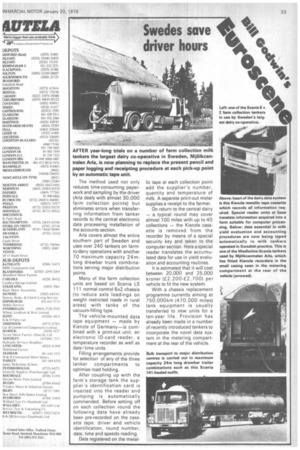driver hours t
Page 35

If you've noticed an error in this article please click here to report it so we can fix it.
AFTER year-long trials on a number of farm collection milk tankers the largest dairy co-operative in Sweden, Mjolkcentralen Aria, is now planning to replace the present pencil and paper logging and receipting procedure at each pick-up point by an automatic tape unit.
The method used not only reduces time-consuming paperwork and sampling by the driver (Ada deals with almost 30,000 farm collection points) but eliminates errors when transferring information from tanker records to the central electronic data processing installation of the accounts section.
Aria covers almost the entire southern part of Sweden and uses over 240 tankers on farmto-dairy operations with another 70 maximum capacity 24mlong drawbar trunk combinations serving major distribution points.
Many of the farm collection units are based on Scania LS 111 normal control 6x2 chassis (to reduce axle loadings on weight restricted roads in rural areas) with tanks of the vacuum-filling type.
The vehicle-mounted data tape equipment — made by Kienzle of Germany—is corn: bined with a print-out unit, an electronic ID-card reader, a temperature recorder as well as date/time units.
Filling arrangements provide for selection of any of the three tanker compartments to optimise road holding.
After coupling up with the farm's storage tank the supplier's identification card is inserted into the reader and pumping is automatically commended. Before setting off on each collection round the following data have already been pre-recorded on the cassette tape: driver and vehicle identification, round number, date, time and speedo reading.
Data registered on the metal
lic tape at each collection point add the supplier's number, quantity and temperature of milk. A separate print-out meter supplies a receipt to the farmer.
On return to the central dairy — a typical round may cover almost 100 miles with up to 40 collections — the Kienzle cassette is removed from the recorder by means of a special security key and taken to the computer section. Here a special reader translates the accumulated data for use in yield evaluation and accounting routines.
It is estimated that it will cost between 20,000 and 25,000 kroner (£2,200-E2,700) per vehicle to fit the new system.
With a chassis replacement programme currently aiming at 750,000km (470,000 miles) tank equipment is usually transferred to new units for a ten-year life. Provision has already been made in a number of,recently introduced tankers to incorporate the novel data system in the metering compartment at the rear of the vehicle.
















































































































